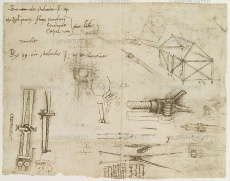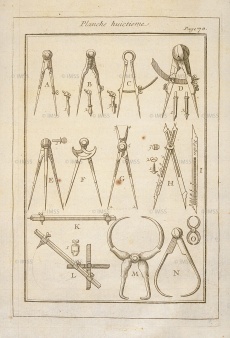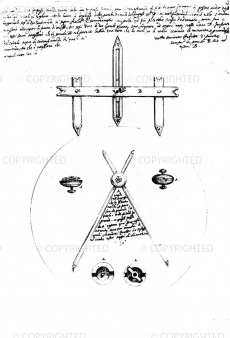Reduction Compasses
From Inventions
m (1 revision) |
|||
| (10 intermediate revisions not shown) | |||
| Line 1: | Line 1: | ||
{{Template invention | {{Template invention | ||
| - | |nome= | + | |nome= |
| + | Name currently used for the compass with intersecting legs, or [[Four-Point Compasses | four-point compasses]]. | ||
|inventore= | |inventore= | ||
| - | |data= | + | |data= 1st C. B.C.? |
| - | |descrizione= | + | |descrizione= |
| + | Instrument used exclusively to reproduce drawings in reduced or enlarged scale, having two legs intersecting at a fixed or mobile centre whose opposed points form simple ratios of 1:2, 1:3 or other (''Vocabolario della Crusca'', 1878). The most ancient was found in the archaeological excavations of Pompeii. In the Renaissance it was known as [[Double Compasses | double compasses]], compasso a centro mobile (compass with mobile centre) (Giacomo Contarini) or ''compasso con le punte doppie'' (compass with double points) (Muzio Oddi, ''Fabbrica et uso del compasso polimetro'', Milan 1633, Introduction), while in modern terminology it is also called [[Four-Point Compasses | four-point compasses]]. | ||
|componenti= | |componenti= | ||
| Line 17: | Line 19: | ||
|strumentiesistenti= | |strumentiesistenti= | ||
| - | [http:// | + | - Museo Galileo, Istituto e museo di storia della scienza, Firenze <br> |
| - | [http:// | + | [http://catalogue.museogalileo.it/object/ReductionCompass_n02.html Florence, Museo Galileo. Institute and Museum of the History of Science, Inv. 3686.]<br /> |
| - | [http:// | + | [http://catalogue.museogalileo.it/object/ReductionCompass.html Florence, Museo Galileo. Institute and Museum of the History of Science, Inv. 655.]<br /> |
| + | [http://catalogue.museogalileo.it/object/ReductionCompass_n01.html Florence, Museo Galileo. Institute and Museum of the History of Science, Inv. 633.]<br /> | ||
| + | |||
| + | |||
| + | - Musée des arts et métiers, Paris<br> | ||
| + | [http://cugnot.cnam.fr:8000/SEARCH/BASIS/COLLEC/INTERNET/objet/DDW?W%3DDESIG+PH+WORDS+%27compas+reduction%27+ORDER+BY+DESIG/Ascend%26M%3D1%26K%3D24208%26R%3DY%26U%3D1 Paris, Musée des arts et metiers, inv. 02755-0000-] <br /> | ||
| + | [http://cugnot.cnam.fr:8000/SEARCH/BASIS/COLLEC/INTERNET/objet/DDW?W%3DDESIG+PH+WORDS+%27compas+reduction%27+ORDER+BY+DESIG/Ascend%26M%3D2%26K%3D24226%26R%3DY%26U%3D1 Paris, Musée des arts et metiers, inv. 08851-0000-] <br /> | ||
| + | [http://cugnot.cnam.fr:8000/SEARCH/BASIS/COLLEC/INTERNET/objet/DDW?W%3DDESIG+PH+WORDS+%27compas+reduction%27+ORDER+BY+DESIG/Ascend%26M%3D3%26K%3D24214%26R%3DY%26U%3D1 Paris, Musée des arts et metiers, inv. 02773-0000-] <br /> | ||
| + | |||
| + | |||
Napoli, Museo Archeologico Nazionale, Inv. 76684 | Napoli, Museo Archeologico Nazionale, Inv. 76684 | ||
|link= | |link= | ||
| + | http://www.informaworld.com/smpp/content~db=all~content=a756424205~frm=titlelink (English) | ||
|immagini= <gallery widths=230 heights=368 perrow=3> | |immagini= <gallery widths=230 heights=368 perrow=3> | ||
Image: 0101-39792.jpg | Leonardo da Vinci. ''Il Codice Atlantico di Leonardo da Vinci : edizione in facsimile dopo il restauro dell'originale conservato nella Biblioteca Ambrosiana di Milano''. Firenze, 1973-1975, c. 1046r.<br /> | Image: 0101-39792.jpg | Leonardo da Vinci. ''Il Codice Atlantico di Leonardo da Vinci : edizione in facsimile dopo il restauro dell'originale conservato nella Biblioteca Ambrosiana di Milano''. Firenze, 1973-1975, c. 1046r.<br /> | ||
| - | |||
| - | |||
Image: 8528_3202_1659-024.jpg | Nicolas Bion. ''Traité de la construction et des principaux usages des instruments de mathematique'', Paris, 1725, tav. 8.<br /> | Image: 8528_3202_1659-024.jpg | Nicolas Bion. ''Traité de la construction et des principaux usages des instruments de mathematique'', Paris, 1725, tav. 8.<br /> | ||
| + | Image: 56696.jpg | Giacomo Contarini. ''Figure d'Istromenti Matematici'', Oxford, c. 1590, c21.<br /> | ||
| + | |||
| + | |||
</gallery> | </gallery> | ||
| Line 37: | Line 50: | ||
|categoria_1= Measuring instruments | |categoria_1= Measuring instruments | ||
| - | |categoria_2= | + | |categoria_2= Drawing instruments |
|categoria_3= | |categoria_3= | ||
|categoria_4= | |categoria_4= | ||
Current revision as of 08:15, 10 September 2010
Name currently used for the compass with intersecting legs, or four-point compasses.
Contents |
Historic Period
1st C. B.C.?
Description
Instrument used exclusively to reproduce drawings in reduced or enlarged scale, having two legs intersecting at a fixed or mobile centre whose opposed points form simple ratios of 1:2, 1:3 or other (Vocabolario della Crusca, 1878). The most ancient was found in the archaeological excavations of Pompeii. In the Renaissance it was known as double compasses, compasso a centro mobile (compass with mobile centre) (Giacomo Contarini) or compasso con le punte doppie (compass with double points) (Muzio Oddi, Fabbrica et uso del compasso polimetro, Milan 1633, Introduction), while in modern terminology it is also called four-point compasses.
Bibliographical Resources
Contarini, Giacomo. Figure d'Istromenti Matematici e loro uso, ms, ca. 1590, Oxford, Bodleian Library, Ms. Canon. Ital. 145, c. 21.
Oddi, Muzio. Fabbrica et uso del compasso polimetro, Milano 1633.
Existing Instruments
- Museo Galileo, Istituto e museo di storia della scienza, Firenze
Florence, Museo Galileo. Institute and Museum of the History of Science, Inv. 3686.
Florence, Museo Galileo. Institute and Museum of the History of Science, Inv. 655.
Florence, Museo Galileo. Institute and Museum of the History of Science, Inv. 633.
- Musée des arts et métiers, Paris
Paris, Musée des arts et metiers, inv. 02755-0000-
Paris, Musée des arts et metiers, inv. 08851-0000-
Paris, Musée des arts et metiers, inv. 02773-0000-
Napoli, Museo Archeologico Nazionale, Inv. 76684
Links (External)
http://www.informaworld.com/smpp/content~db=all~content=a756424205~frm=titlelink (English)
Images
Author of the entry: Filippo Camerota



